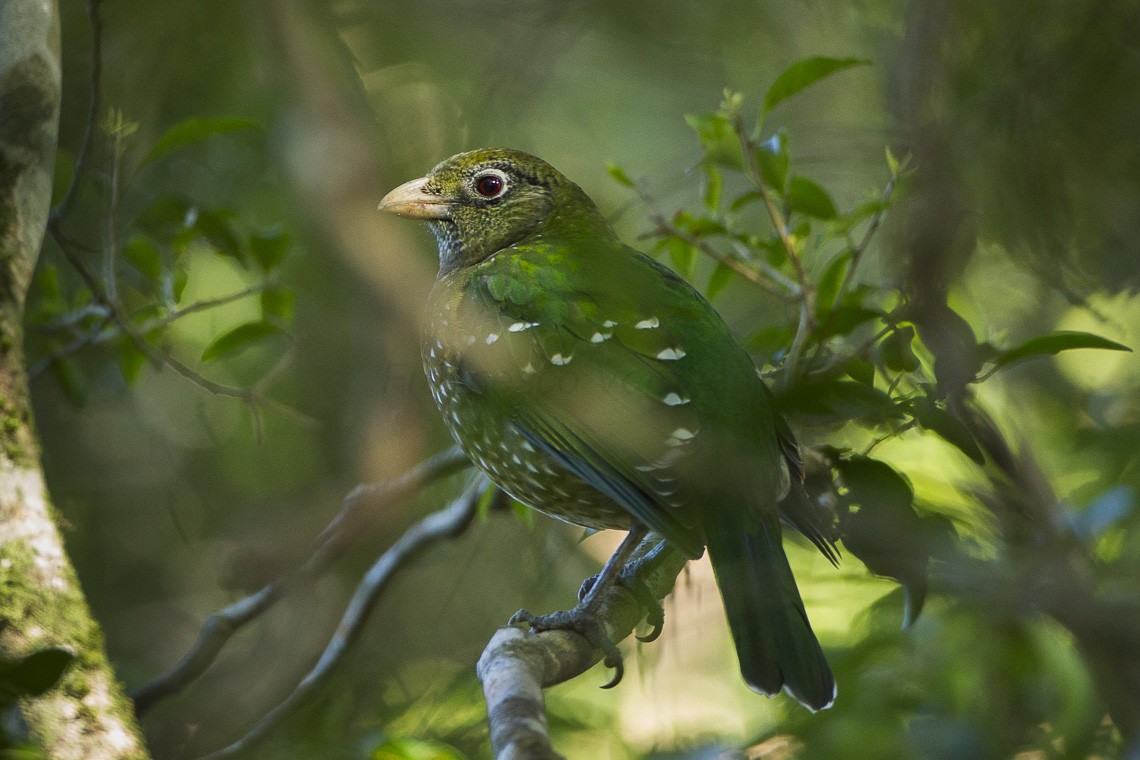Green Catbird
A species of Australo-papuan Catbirds Scientific name : Ailuroedus crassirostris Genus : Australo-papuan Catbirds
Green Catbird, A species of Australo-papuan Catbirds
Botanical name: Ailuroedus crassirostris
Genus: Australo-papuan Catbirds
Content
Description General Info
 Photo By Francesco Veronesi , used under CC-BY-SA-2.0 /Cropped and compressed from original
Photo By Francesco Veronesi , used under CC-BY-SA-2.0 /Cropped and compressed from original Description
Green catbirds are a medium-sized stocky bird with long, powerful legs and a long, stout bill. The back, wings and rump are brilliant emerald green, with very conspicuous pure white spots at the tips of the tertiaries and secondaries, which, on the tips of coverts, form two white wing-bars. The tail is brownish emerald with white tips. The head is greenish brown mottled black and finely flecked pale buff. The chest is greenish buff to dull emerald with distinctive short white streaks. The bill is horn coloured and the legs are greyish brown. The iris is bright red in direct sun with a partial white eye-ring. Male and female birds share similar plumage, making it very difficult to distinguish between the sexes. Juvenile birds also have similar plumage, although it is duller. Very young birds have fluffy grey down on their heads (Donaghey. R. 1996). 
Size
31 cm
Life Expectancy
8-15 years
Nest Placement
Tree
Feeding Habits
Green Catbird are omnivorous with a focus on frugivory, consuming figs, various plant matter, and occasional insects or small vertebrates. They forage actively in tree canopies, adapting to orchards when natural foods are sparse.
Habitat
Green Catbird predominantly inhabits subtropical and temperate rainforests, often around watercourses and including environments such as paperbark wetlands. Secondary habitats include eucalypt forests, woodland edges, gardens, and orchards. This bird species prefers regions with fig trees, which are vital food sources during breeding seasons. They establish territories that facilitate access to abundant fruit supplies and water for drinking and bathing. Habitually, green Catbird is found at elevations from sea level up to approximately 1000 meters.
Dite type
Frugivorous
General Info
Feeding Habits
Bird food type

Fruit
Behavior
Although usually seen individually, green catbirds typically socialize in pairs but can be seen in groups of 3–5 at the end of breeding season when their young are still somewhat dependent on their parents. Green catbirds do not flock but outside of breeding seasons it is not uncommon to see them in groups of around 20 birds all feeding in mutual territories, this is most common during winter fruiting seasons. Amongst these groups of green catbirds other species that can be found during these communal feeds are satin bowerbirds, regent bowerbirds and fig birds Green catbirds will constantly spend their time seeking out food sources both inside and outside their territories and fiercely defend food sources within their territory from other males and females. Patrolling their territory also makes up a large portion of their daily activity. They will be heard regularly calling but this is most common during breeding season, when predators are in the vicinity of nests and when engaging other birds in territorial battles. 
Distribution Area
According to The Field Guide to Australian Birds (Michael Morcombe, 2003) (2nd edition), green catbirds are found along the length of the east coast of NSW (in areas of suitable habitat) through to the Cooloola Coast in South East Queensland. The birds are found in subtropical and temperate rainforest and paperbarks, and occasionally in adjacent eucalypt forest. The average home range of the birds is five acres, although this is greatly reduced during breeding season. Breeding territories usually contain several fig trees which regularly produce large amounts of ripe fruit for several months which coincides with the catbird breeding season. Green catbirds drink and bath in pools of water that are found in the crevices of surrounding trees or water courses. 
Species Status
Although the green catbird is listed as Least Concern on IUCN Red List of Threatened Species, it is listed as Vulnerable in NSW, which is the majority of its range. Although it is widespread and common in its favoured habitat, ongoing clearing of rainforest and paperbark swamps for development is likely to continue to threaten the green catbird in the future. 
Scientific Classification
Phylum
Chordates Class
Birds Order
Perching birds Family
Bowerbirds Genus
Australo-papuan Catbirds Species
Green Catbird